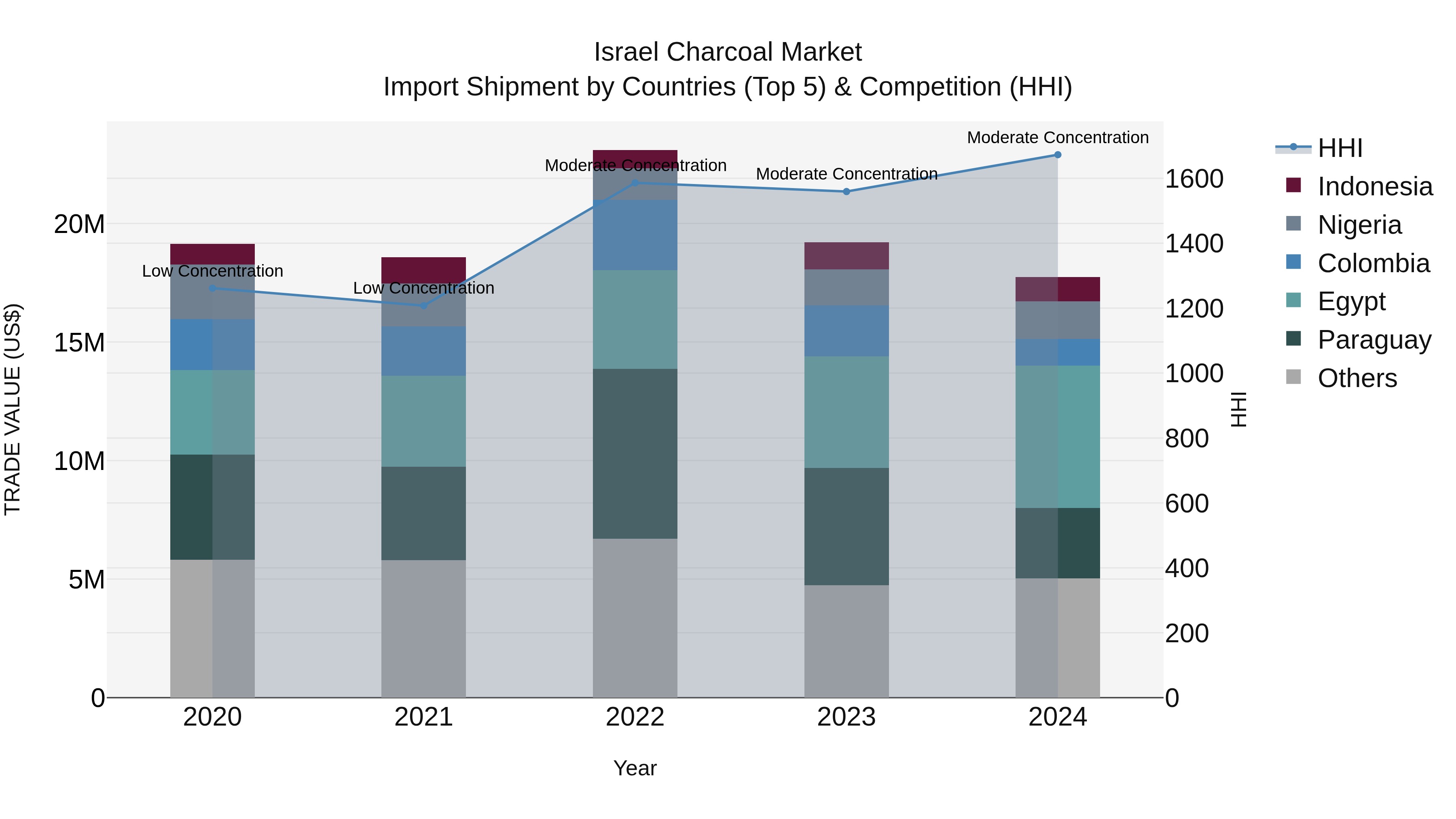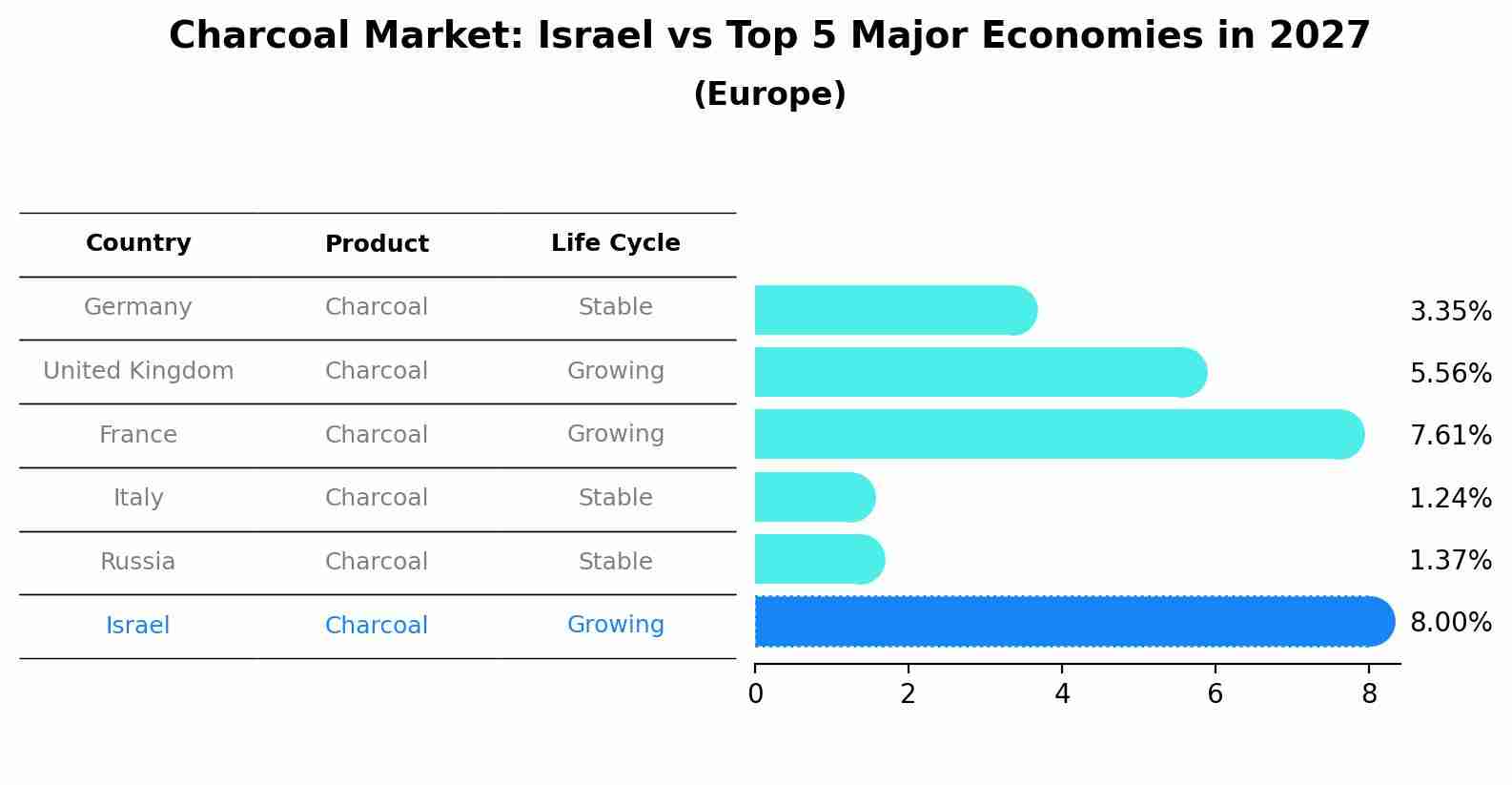Israel Charcoal Market (2025-2031) | Value, Analysis, Outlook, Growth, Share, Trends, Companies, Forecast, Size, Revenue, Industry & Segmentation
| Product Code: ETC4686303 | Publication Date: Nov 2023 | Updated Date: Nov 2025 | Product Type: Market Research Report | |
| Publisher: 6Wresearch | Author: Shubham Padhi | No. of Pages: 60 | No. of Figures: 30 | No. of Tables: 5 |
Israel Charcoal Market Top 5 Importing Countries and Market Competition (HHI) Analysis
Israel`s charcoal import market in 2024 saw significant contributions from Egypt, Paraguay, Nigeria, USA, and Colombia. Despite a negative Compound Annual Growth Rate (CAGR) of -1.87% from 2020 to 2024 and a decline in growth rate of -7.58% from 2023 to 2024, the Herfindahl-Hirschman Index (HHI) indicated a moderate concentration level in the market. This data suggests that while there was a decrease in growth, the market remained stable with key exporters continuing to play a significant role in supplying charcoal to Israel.

Charcoal Market: Israel vs Top 5 Major Economies in 2027 (Europe)
The Charcoal market in Israel is projected to grow at a growing growth rate of 8.00% by 2027, within the Europe region led by Germany, along with other countries like United Kingdom, France, Italy and Russia, collectively shaping a dynamic and evolving market environment driven by innovation and increasing adoption of emerging technologies.

Israel Charcoal Market Synopsis
The Israel charcoal market is characterized by robust demand from various sectors, including residential, commercial, and industrial. Factors such as increasing barbecue culture, growing popularity of outdoor cooking, and rising disposable incomes are driving the demand for charcoal in Israel. Market players are focusing on product diversification and sustainability initiatives to capitalize on emerging opportunities.
Drivers of the market
The charcoal market in Israel is influenced by factors such as changing consumer preferences, lifestyle trends, and cultural traditions. Charcoal is widely used for grilling and barbecuing purposes, especially during outdoor gatherings and festivities. As disposable income levels rise and leisure activities gain importance, the demand for high-quality charcoal products grows. Moreover, the growing popularity of outdoor cooking enthusiasts and the emergence of innovative charcoal variants, such as flavored and sustainable options, further propel market growth.
Challenges of the market
The Israel charcoal market faces multifaceted challenges, including environmental sustainability concerns and changing consumer preferences. Increasing awareness about deforestation and carbon emissions associated with traditional charcoal production has led to growing demand for sustainable alternatives such as coconut shell or bamboo charcoal. However, the higher cost of these alternatives and limited availability pose significant challenges for market players. Furthermore, fluctuations in disposable income and dietary habits influence the demand for charcoal products, requiring manufacturers to adapt their marketing strategies accordingly.
Government Policy of the market
The charcoal market in Israel is subject to regulations aimed at protecting forests and preventing deforestation. Government policies may include restrictions on the harvesting of wood for charcoal production, as well as regulations on the importation and sale of charcoal to ensure product quality and safety standards are met.
Key Highlights of the Report:
- Israel Charcoal Market Outlook
- Market Size of Israel Charcoal Market, 2024
- Forecast of Israel Charcoal Market, 2031
- Historical Data and Forecast of Israel Charcoal Revenues & Volume for the Period 2021-2031
- Israel Charcoal Market Trend Evolution
- Israel Charcoal Market Drivers and Challenges
- Israel Charcoal Price Trends
- Israel Charcoal Porter`s Five Forces
- Israel Charcoal Industry Life Cycle
- Historical Data and Forecast of Israel Charcoal Market Revenues & Volume By Type for the Period 2021-2031
- Historical Data and Forecast of Israel Charcoal Market Revenues & Volume By Lump Charcoal for the Period 2021-2031
- Historical Data and Forecast of Israel Charcoal Market Revenues & Volume By Charcoal Briquettes for the Period 2021-2031
- Historical Data and Forecast of Israel Charcoal Market Revenues & Volume By Japanese Charcoal for the Period 2021-2031
- Historical Data and Forecast of Israel Charcoal Market Revenues & Volume By Sugar Charcoal for the Period 2021-2031
- Historical Data and Forecast of Israel Charcoal Market Revenues & Volume By Application for the Period 2021-2031
- Historical Data and Forecast of Israel Charcoal Market Revenues & Volume By Metallurgical Fuel for the Period 2021-2031
- Historical Data and Forecast of Israel Charcoal Market Revenues & Volume By Barbecue for the Period 2021-2031
- Historical Data and Forecast of Israel Charcoal Market Revenues & Volume By Industrial for the Period 2021-2031
- Historical Data and Forecast of Israel Charcoal Market Revenues & Volume By Filtration for the Period 2021-2031
- Israel Charcoal Import Export Trade Statistics
- Market Opportunity Assessment By Type
- Market Opportunity Assessment By Application
- Israel Charcoal Top Companies Market Share
- Israel Charcoal Competitive Benchmarking By Technical and Operational Parameters
- Israel Charcoal Company Profiles
- Israel Charcoal Key Strategic Recommendations
Frequently Asked Questions About the Market Study (FAQs):
1 Executive Summary |
2 Introduction |
2.1 Key Highlights of the Report |
2.2 Report Description |
2.3 Market Scope & Segmentation |
2.4 Research Methodology |
2.5 Assumptions |
3 Israel Charcoal Market Overview |
3.1 Israel Country Macro Economic Indicators |
3.2 Israel Charcoal Market Revenues & Volume, 2021 & 2031F |
3.3 Israel Charcoal Market - Industry Life Cycle |
3.4 Israel Charcoal Market - Porter's Five Forces |
3.5 Israel Charcoal Market Revenues & Volume Share, By Type, 2021 & 2031F |
3.6 Israel Charcoal Market Revenues & Volume Share, By Application, 2021 & 2031F |
4 Israel Charcoal Market Dynamics |
4.1 Impact Analysis |
4.2 Market Drivers |
4.3 Market Restraints |
5 Israel Charcoal Market Trends |
6 Israel Charcoal Market Segmentations |
6.1 Israel Charcoal Market, By Type |
6.1.1 Overview and Analysis |
6.1.2 Israel Charcoal Market Revenues & Volume, By Lump Charcoal, 2021-2031F |
6.1.3 Israel Charcoal Market Revenues & Volume, By Charcoal Briquettes, 2021-2031F |
6.1.4 Israel Charcoal Market Revenues & Volume, By Japanese Charcoal, 2021-2031F |
6.1.5 Israel Charcoal Market Revenues & Volume, By Sugar Charcoal, 2021-2031F |
6.2 Israel Charcoal Market, By Application |
6.2.1 Overview and Analysis |
6.2.2 Israel Charcoal Market Revenues & Volume, By Metallurgical Fuel, 2021-2031F |
6.2.3 Israel Charcoal Market Revenues & Volume, By Barbecue, 2021-2031F |
6.2.4 Israel Charcoal Market Revenues & Volume, By Industrial, 2021-2031F |
6.2.5 Israel Charcoal Market Revenues & Volume, By Filtration, 2021-2031F |
7 Israel Charcoal Market Import-Export Trade Statistics |
7.1 Israel Charcoal Market Export to Major Countries |
7.2 Israel Charcoal Market Imports from Major Countries |
8 Israel Charcoal Market Key Performance Indicators |
9 Israel Charcoal Market - Opportunity Assessment |
9.1 Israel Charcoal Market Opportunity Assessment, By Type, 2021 & 2031F |
9.2 Israel Charcoal Market Opportunity Assessment, By Application, 2021 & 2031F |
10 Israel Charcoal Market - Competitive Landscape |
10.1 Israel Charcoal Market Revenue Share, By Companies, 2024 |
10.2 Israel Charcoal Market Competitive Benchmarking, By Operating and Technical Parameters |
11 Company Profiles |
12 Recommendations | 13 Disclaimer |
- Single User License$ 1,995
- Department License$ 2,400
- Site License$ 3,120
- Global License$ 3,795
Search
Thought Leadership and Analyst Meet
Our Clients
Related Reports
- Canada Oil and Gas Market (2026-2032) | Share, Segmentation, Value, Industry, Trends, Forecast, Analysis, Size & Revenue, Growth, Competitive Landscape, Outlook, Companies
- Germany Breakfast Food Market (2026-2032) | Industry, Share, Growth, Size, Companies, Value, Analysis, Revenue, Trends, Forecast & Outlook
- Australia Briquette Market (2025-2031) | Growth, Size, Revenue, Forecast, Analysis, Trends, Value, Share, Industry & Companies
- Vietnam System Integrator Market (2025-2031) | Size, Companies, Analysis, Industry, Value, Forecast, Growth, Trends, Revenue & Share
- ASEAN and Thailand Brain Health Supplements Market (2025-2031) | Strategy, Consumer Insights, Analysis, Investment Trends, Opportunities, Growth, Size, Share, Industry, Revenue, Segments, Value, Segmentation, Supply, Forecast, Restraints, Outlook, Competition, Drivers, Trends, Demand, Pricing Analysis, Competitive, Strategic Insights, Companies, Challenges
- ASEAN Bearings Market (2025-2031) | Strategy, Consumer Insights, Analysis, Investment Trends, Opportunities, Growth, Size, Share, Industry, Revenue, Segments, Value, Segmentation, Supply, Forecast, Restraints, Outlook, Competition, Drivers, Trends, Demand, Pricing Analysis, Competitive, Strategic Insights, Companies, Challenges
- Europe Flooring Market (2025-2031) | Outlook, Share, Industry, Trends, Forecast, Companies, Revenue, Size, Analysis, Growth & Value
- Saudi Arabia Manlift Market (2025-2031) | Outlook, Size, Growth, Trends, Companies, Industry, Revenue, Value, Share, Forecast & Analysis
- Uganda Excavator, Crane, and Wheel Loaders Market (2025-2031) | Strategy, Consumer Insights, Analysis, Investment Trends, Opportunities, Growth, Size, Share, Industry, Revenue, Segments, Value, Segmentation, Supply, Forecast, Restraints, Outlook, Competition, Drivers, Trends, Demand, Pricing Analysis, Competitive, Strategic Insights, Companies, Challenges
- Rwanda Excavator, Crane, and Wheel Loaders Market (2025-2031) | Strategy, Consumer Insights, Analysis, Investment Trends, Opportunities, Growth, Size, Share, Industry, Revenue, Segments, Value, Segmentation, Supply, Forecast, Restraints, Outlook, Competition, Drivers, Trends, Demand, Pricing Analysis, Competitive, Strategic Insights, Companies, Challenges
Industry Events and Analyst Meet
Whitepaper
- Middle East & Africa Commercial Security Market Click here to view more.
- Middle East & Africa Fire Safety Systems & Equipment Market Click here to view more.
- GCC Drone Market Click here to view more.
- Middle East Lighting Fixture Market Click here to view more.
- GCC Physical & Perimeter Security Market Click here to view more.
6WResearch In News
- Doha a strategic location for EV manufacturing hub: IPA Qatar
- Demand for luxury TVs surging in the GCC, says Samsung
- Empowering Growth: The Thriving Journey of Bangladesh’s Cable Industry
- Demand for luxury TVs surging in the GCC, says Samsung
- Video call with a traditional healer? Once unthinkable, it’s now common in South Africa
- Intelligent Buildings To Smooth GCC’s Path To Net Zero


















